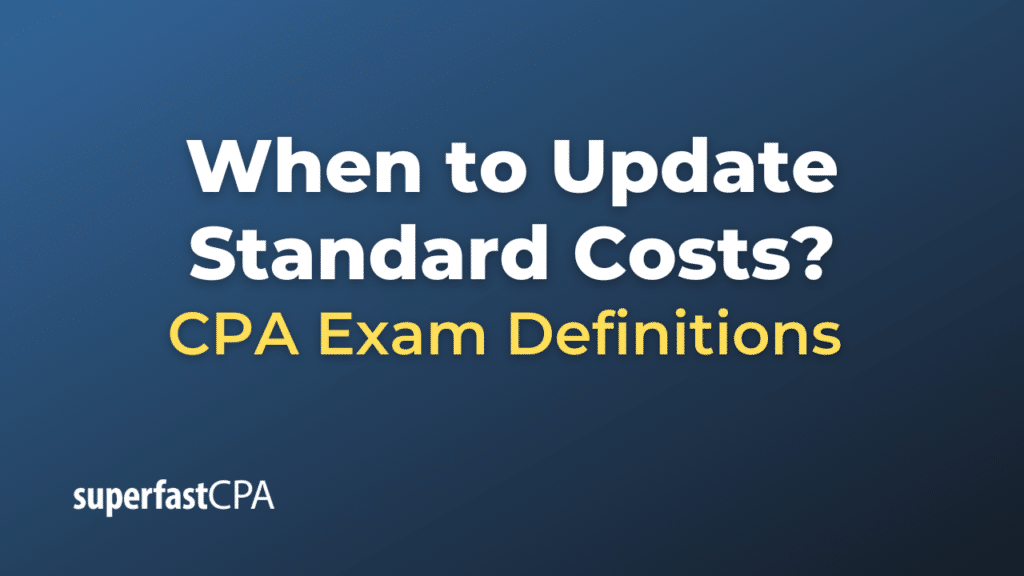When to Update Standard Costs
The timing for updating standard costs can vary depending on the industry, the volatility of cost elements, and the management practices of a particular company. Standard costs are pre-determined or estimated costs that serve as benchmarks for assessing actual performance. Here are some common triggers and scenarios when standard costs might be updated:
Triggers for Updating Standard Costs:
- Periodic Review: Many companies review standard costs annually during the budgeting process. This allows for a comprehensive look at expected costs for the coming year.
- Significant Fluctuations in Costs: If the costs of raw materials or labor change substantially, companies may update their standard costs more frequently. For example, if there is a significant increase in steel prices, a car manufacturer might update its standard costs during the year.
- Introduction of New Products or Processes: Whenever a new product is introduced or an existing production process is modified, the standard costs may need to be recalculated.
- Regulatory Changes: Changes in legislation, such as minimum wage increases or new environmental regulations, can also necessitate an update in standard costs.
- Currency Fluctuations: For international operations, changes in exchange rates can significantly impact costs, requiring an update to standard costs.
- Periodic Variance Analysis: If variances between actual costs and standard costs consistently appear to be significant, this is an indicator that the standard costs may be outdated.
- Management Strategy: Sometimes, changes in corporate strategy or production methods can also be a trigger for updating standard costs.
Accounting Treatment:
Once standard costs are updated, it’s crucial to apply these new standards to future production runs and also possibly adjust any existing inventory valuations to align with the new standard costs. Further, management should analyze the variances between the new standard costs and actual costs to evaluate performance and identify areas for improvement.
Keeping standard costs up-to-date is vital for accurate financial reporting, effective management decision-making, and operational efficiency.
Example of When to Update Standard Costs
Certainly, let’s consider a simplified example involving a company called “EcoFurnish,” which manufactures wooden chairs. EcoFurnish typically updates its standard costs annually but is facing a significant rise in lumber costs in the middle of the year. The standard cost of producing one chair was initially set at $100, which includes:
- Lumber: $50
- Labor: $30
- Overhead: $20
Situation:
- Annual Update: At the beginning of the year, during the budgeting process, EcoFurnish establishes the standard costs as mentioned above.
Initial Accounting Entry for Standard Costs:
Debit: Work in Progress Inventory $100
Credit: Raw Materials Inventory $50
Credit: Labor Costs $30
Credit: Overhead Costs $20 - Mid-Year Update: Six months into the year, the cost of lumber rises by 20% due to supply shortages, which means the new cost is $60 instead of $50.
Action Steps:
Given the significant increase in lumber costs, EcoFurnish decides to update its standard costs. The new standard cost for a chair would now be $110:
- Lumber: $60 (Updated)
- Labor: $30 (Unchanged)
- Overhead: $20 (Unchanged)
Accounting Treatment:
- Updating Standard Costs in Books: The new standard cost of $110 per chair will be used for all new production runs starting from the point of update.
New Accounting Entry for Standard Costs:
Debit: Work in Progress Inventory $110
Credit: Raw Materials Inventory $60
Credit: Labor Costs $30
Credit: Overhead Costs $20 - Variance Analysis: Now, it’s more critical than ever for EcoFurnish to compare the actual costs against the new standard costs. Any variance needs to be analyzed to understand whether the rise in costs is justified or whether other areas need to be optimized.
Practical Considerations:
- If there’s existing inventory that has been valued using the old standard costs, some companies might adjust the value of this inventory to align it with the new standard costs.
- The increase in standard costs could lead to higher product pricing or a search for cost-cutting elsewhere in the manufacturing process.
By updating the standard costs, EcoFurnish ensures that it has a more accurate basis for performance evaluation, pricing decisions, and financial reporting.













